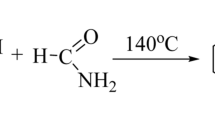Abstract
Two synthetic 2,6-disubstituted 4-anilinoquinazolines exerted a significant effect on the G+ bacteriaBacillus subtilis andStaphylococcus aureus. None of 12 tested derivatives influencedEscherichia coli, Proteus mirabilis andPseudomonas aeruginosa. Derivatives having the aromatic ring non-substituted or substituted by bromine, the pyrimidine ring by phenyl, morpholine or piperidine and the aniline skeleton non-substituted or substituted by methyl or amino group exterted a considerable antibacterial activity.
Similar content being viewed by others
References
Abdelmegeed M.F., Yassin S.F., Elshanshour A.F., Elbadawi M.: Synthesis of some new chloro derivatives of quinazolino-(4,3-β)quinazolin-8-one ands-tetrazolo(4,3-c)quinazoline with expected antifungicidal and antibacterial activities.Rev. Roum. Chim.39, 189–197 (1994).
Bodajla M., Stankovský Š., Špirková K., Jantová S., Hudecová D.: Azolylquinazolines, synthesis and biological activity.Chem. Papers48, 432–436 (1994).
Denny W.A., Rewcastle G.W., Bridges A.J., Fry D.W., Kraker A.J.: Structure-activity relationships for 4-anilinoquinazolines as potent inhibitors at the ATP binding-site of the epidermal growth-factor receptorin vitro.Clin. Exp. Pharm. Physiol.23, 424–427 (1996).
Elzohry M.F., Elhamed A., Ahmed N., Omar F.A., Abdalla M.A.: Synthesis and antibacterial activity of certain quinoline and quinazoline derivatives containing sulfide and sulfone moieties.J. Chem. Technol. Biotechnol.53, 329–336 (1992).
Farghaly A.M., Chaaban I., Khalil M.A., Bekhit A.A.: Nonsteroidal antiinflammatory agents. Synthesis of novel 2-pyrazolyl-4(3H)-quinazolines.Arch. Pharm.323, 833–836 (1990).
Farghaly A.M., Monsen A., Omar M.E., Khalil M.A., Gaber M.A.: Synthesis of 3-aryl-2-substituted 4(3H)-quinazolines as potential antimicrobial agents.Farmaco45, 431–438 (1990).
Gabriel S.: Über das Chinazolin.Ber. Deut. Chem. Ges.36, 800–813 (1903).
Greifs P.: Über die Einwirkung des Cyans auf Anthranilsäure.Ber. Deut. Chem. Ges.2, 415–418 (1869).
Gursoy A., Karali N.: Synthesis and anticovulsant activity of new acylthiosemicarbazides and thiazolidones.Farmaco50, 857–866 (1995).
Jantová S., Hudecová D., Špirková K., Stankovský Š.: Structure-activity relationships of some 4-quinazolylthiosemicarbazides and their triazolo derivatives.Folia Microbiol.39, 471–474 (1994).
Jantová S., Hudecová D., Stankovský Š., Špirková K., Ružeková L'.: Antibacterial effect of substituted 4-quinazolylhydrazines and their arylhydrazones determined by modified microdilution method.Folia Microbiol.40, 611–614 (1995).
Jantová S., Baláž Š., Stankovský Š., Špirková K., Lukáčová V.: Relationships between the structure, cytotoxicity and hydrophobicity of quinazoline derivatives by quantitative structure-activity relationship.Folia Biol.43, 83–89 (1997a).
Jantová S., Labuda J., Vollek V., Zastková M.: Antimicrobial effect of the macrocyclic Cu(II)-tetraanhydroaminobenzaldehyde complex.Folia Microbiol.42, 324–326 (1997b).
Kurogi Y., Inoue Y., Tsutsumi K., Nakamura S., Nagao K., Yoshitsugu H., Tsuda Y.: Synthesis and hypolipidemis activities of novel 2-(4-[(diethoxyphosphoryl)methyl]phenyl)quinazolines and 4(3H)-quinazolinones.J. Med. Chem.39, 1433–1437 (1996).
Peet N.P., Baugh L.E., Lewis J.E., Matthews E.H., Olberding E.L., Shan D.N., Sunder S.: Chemistry and antiallergic activity of 3-(1H-tetrazol-5-yl)-4-(3H)-quinazoline sodium-salt (MDL-427).Abstr. Pap. Amer. Chem. Soc.192, 13 (1986).
Pomarnacka E., Angielski S., Hoppe A.: Derivatives of 4-chloro-5-sulfanoylbenzoic acid. 8. Synthesis and diuretic activity of pyrazole(3,2)quinazoline and 1-benzoylpyrazole derivatives.Acta Polon. Pharm.41, 141–151 (1984).
Saksena R.K., Kant P.: Synthesis and antibacterial activity of azomethines and thiazolidinones derived from 2-phenyl-3-(p-aminodiphenyl)-4-quinazolones.J. Indian Chem. Soc.61, 722–724 (1984)
Stankovský Š., Bukovská V.: Reactions of amidinoyl isothiocyanates with N-sulfinylanilines.Chem. Papers37, 831–836 (1983).
Stankovský Š., Mrázová D.: Preparation of substituted 2-phenyl-4-anilinoquinazolines through imidoylcarbodiimides.Chem. Papers38, 549–555 (1984).
Stankovský Š., Bodajla M., Špirková K., Jantová S.: Preparation of some 4-anilino-1,3-benzodiazines and related 4-anilino-6H-5,1,3-benzothiadiazocines, pp. 125–126 inAbstracts of Symposium on Heterocyclic Compounds: Synthesis, Structure and Biological Activity, Hradec Králové (Czech Republic) 1995.
Takemura Y., Jackman A.L.: Folate-based thymidylate synthase inhibitors in cancer chemotherapy.Anti-Cancer Drugs8, 3–16 (1997).
Author information
Authors and Affiliations
Corresponding author
Rights and permissions
About this article
Cite this article
Gottasová, R., Kubíková, J. & Čipák, L. Antibacterial effect of some 2,6-disubstituted 4-anilinoquinazolines. Folia Microbiol 43, 679–682 (1998). https://doi.org/10.1007/BF02816389
Received:
Revised:
Issue Date:
DOI: https://doi.org/10.1007/BF02816389



